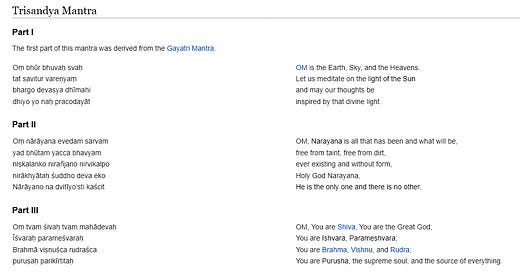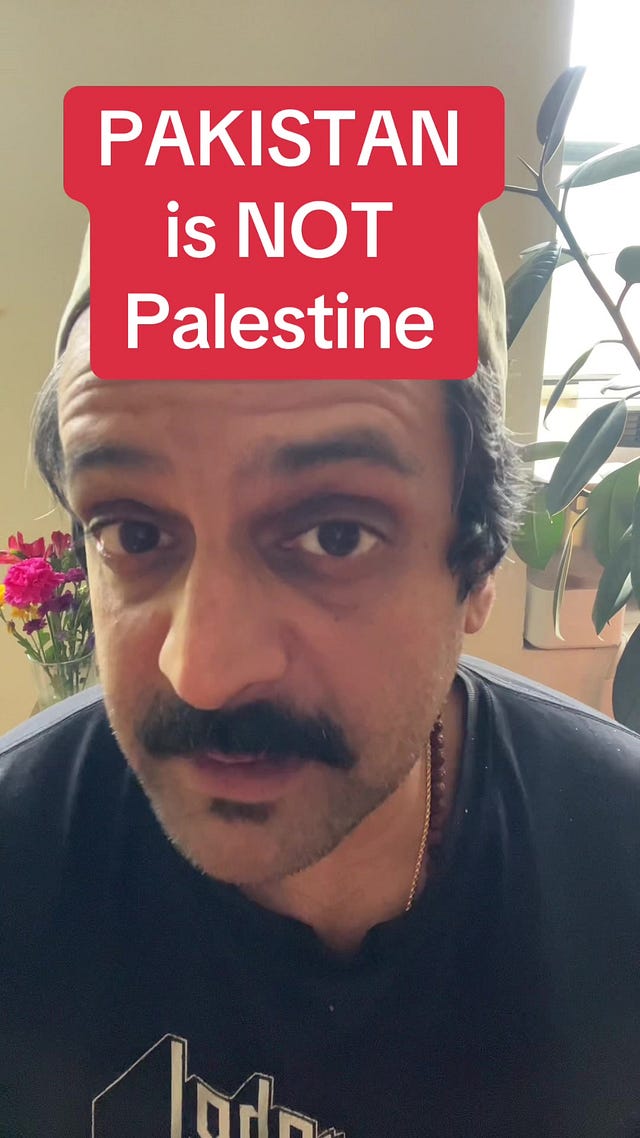Week 282: Indonesian Hindu Daily Prayer, Meme, Debunking Indo-Pak Israel-Palestine, Aesthetic
05/10/2025 - Modern Hindu Content
Welcome to Eternal Path! This week we feature: the Indonesian Hindu daily prayer, a meme, a video debunking India-Israel + Pakistan:Palestine comparisons, and an aesthetic!
Praxis Highlight: Trisandhya
Trisandhya is a ritual in Bali, done three times a day. It is reminiscent of the sandhyavandhnam ritual that Brahmins traditionally are expected to observe, except in Bali’s case it is universal to all Hindus. However, the modern trisandhya is actually of recent origin and its origins lie in Indonesia’s struggle to define the role of religion in its identity. Below is the text of the trisandhya:
After Indonesia’s independence, many involved in their freedom movement wanted to create an Islamic state, while others wanted a secular state. The compromise was a state philosophy of the five principles, or pancasila (a term of Sanskrit origin):
Key to this is principle 1 (ketuhanan yang Maha Esa - belief in the one and only God). If “Maha Esa” looks familiar to you, that’s because it also is a Sanskrit phrase mahesha, meaning Lord Shiva! Originally the Indonesian government, after independence in 1945, used this principle to only recognize Islam and Christianity. Additionally, every citizen had to declare fealty to a religion. Balinese Hindus, along with Sanskrit/Hindu priests and experts from India, ultimately were able to get Hinduism recognized (a story for another day).
Part of the legalization process of Hinduism involved demonstrating that Hinduism had a formal declaration of faith/prayer. This is where Balinese scholars and their Indian partners had to get creative. The Balinese Hindu leaders and the Indians helping them, came up with the concept of trisandhya, likely modeled off sandhya vandhanam, and started digging into ancient Indonesian Hindu texts to find references of trisandhya. The Old Javanese English Dictionary (OJED) listed occurrences of the word and related forms in various Old Javanese texts, including early kakawins (like Rāmāyaṇa), parwas (Ādiparwa, Agastyaparwa, Brahmāṇapurāṇa), and later Javano-Balinese works. Below are a couple of the ancient direct references:
The Javano-Balinese Śaiva text Dewa Tattwa mentions trisandhyā as a mantra for consecrating temple deposits and statues, and lists it among purifying mantras (paṅlukatan). What specific mantra is referred to as trisandhyā in this context is unclear. The Sārasamuccaya, regarded as an authoritative scripture, defines snāna ('ritual bath') as trisandhyāsewana ('worship at dawn, noon and sunset')
Pandit Narendra Shastri, one of the Indian scholars helping the Balinese Hindu leaders, published a booklet in 1951 containing a five-verse version, drawing from sources like the Weda Parikrama, Catur Weda, and Śivastava. I Gusti Bagus Sugriwa, a Balinese Hindu published a different, six-verse version in 1953. Later, Pandit Shastri published a six-verse version that incorporated one of Sugriwa's verses and by 1956, Pandit Shastri and Sugriwa seemed to agree on a widely spread six-verse composition, which was published in their respective books.
The first verse is the Gāyatrī mantra, the second from Yajurweda Śirah (Catur Weda), the third from Śivastava, and the fourth, fifth, and sixth from Weda Parikrama (specifically part of Weda Pengaksama)
The newly composed and standardized PTS was first instituted in Balinese schools in the 1950s and 1960s, becoming a daily prayer for children, which helped introduce a generation into the religious reforms and facilitated the "internal conversion" of Balinese Hinduism into a standard Hinduism. The PHDI further promoted its spread through radio broadcasts starting in the 1980s (like RRI) and television (Bali TV). Since 2001, many community meeting halls (banjar) have been broadcasting the PTS via loudspeakers three times a day, akin to a Balinese "call to prayer”.
Many in Bali will stop what they are doing and use it as a moment of meditation and reflection when they hear the trisandhya, and it is now a fixture in Balinese and broader Indonesian Hindu life. Here is what it sounds like recited in traditional Balinese chanting.
Meme Highlight: The Butcher of Bangladesh
Mohammad Yunus, current leader of Bangladesh rose to power in a so-called “student protest” which led to Islamists going on violent orgies on Hindus and other ethnoreligious minorities in Bangladesh. We have covered the fallout of the “student protest” in a few recent issues, notably: Week 245, Week 243, and Week 242.
Current Events Highlight: Rubbishing India-Israel, Pakistan-Palestine
Pakistani influencers, Islamists, and their Western leftist allies are trying to make the claim that India is a bully country (like Israel in their view) unleashing destruction on innocent Pakistan (seen as analogous to Palestine in their view). We are not here to tell you what to think on Israel-Palestine, a war between two Abrahamic groups far away from places with a significant Hindu population. We are here to tell you that this propaganda is all over TikTok, X/Twitter, Instagram Reels and social media and we see a number of “South Asian” Americans promoting it, meaning the children in your lives, you, your peers, and the broader community is being fed a disgusting, ahistorical, and most importantly, completely false narrative about Hindus.
Pranav Behari has a great video rubbishing this comparison, linked here, and displayed below. Its worth sharing widely and reposting.
 Tiktok failed to load.
Tiktok failed to load.Enable 3rd party cookies or use another browser







